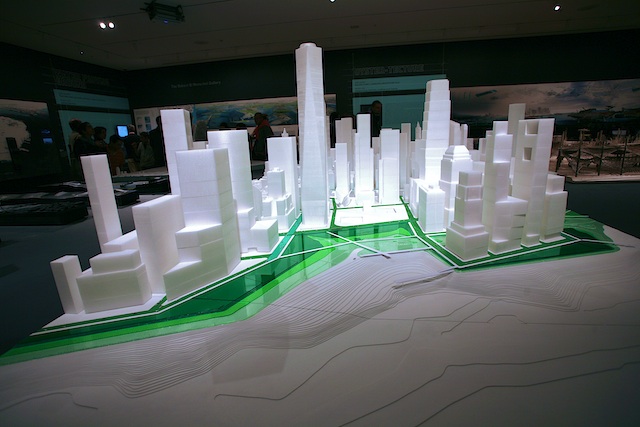"Rising Currents", a current exhibition at the Museum of Modern Art presents a dazzling synthesis of environmental science, art, architecture and visionary design. The work, by five interdisciplinary teams of design and architectural firms, re-visions the urban landscape of New York City to confront a world altered by rising sea levels and storm surges induced by climate change.
The exhibit space dramatically presents a series of design ideas expressed through display boards, multimedia, physical models, and computerized data visualizations.
The design work is supported by a foundation of detailed scientific analysis, documented in Guy Nordenson's remarkable book, On the Water|Palisade Bay (a product of beautiful design in its own right - kudos to Lizzie Hodges). The teams used the tools of science - fluid dynamic modeling, geographic information systems, quantitative analysis of dynamic systems - to inform environmentally and socially sustainable landscape and infrastructural designs.
The resulting design strategies seek to offer protection to the urbanized spaces of Lower Manhattan and Palisade Bay from rising seas and increased storm intensity and frequency. In some cases, they do so by inviting the water to enter and to accommodate its presence through softened infrastructure and landscapes which "rethink the thresholds of water, land, and city". The design objectives include construction "of an archipelago of islands and reefs along the shallow shoals of the New York–New Jersey Upper Bay to dampen powerful storm currents as well as encourage the development of new estuarial habitats","revitalize the waterfront by designing a broad, porous, 'fingered' coastline which combines tidal marshes, parks, and piers for recreation and community development."
The visualization of these new spaces forces the viewer to re-evaluate the relationship between "natural" forces and human activity which now so dramatically influences them. This is an exhibit for the scientist, the artist, and the concerned citizen in each of us. A detailed exhibition blog provides more information. The exhibit runs through October 11, 2010.
(Exhibition photography © 2010 Armen Elliott Photography, www.armenphotography.com).
 Elliott & Elliott announces the launch of a new publicly-available Dropbox archive of documents relating to the proposed PennEast natural gas pipeline. The archive, which will be continuously updated, includes documents from the Federal Energy Regulatory Commission (FERC) docket for the PennEast pipeline project (PF15-1), the Delaware River Basin Commission (DRBC), and other agencies and organizations. The archive also includes guides to accessing electronic information at FERC Online, including instructions on subscribing to a docket, and the FERC "citizen guide", An Interstate Natural Gas Facility on My Land: What Do I Need to Know?
The Dropbox archive is available at: https://www.dropbox.com/sh/fwhs6dcjtmrptq9/AABmUxo8I0N4z_n_l4J-WJ8Ea?dl=0
Elliott & Elliott announces the launch of a new publicly-available Dropbox archive of documents relating to the proposed PennEast natural gas pipeline. The archive, which will be continuously updated, includes documents from the Federal Energy Regulatory Commission (FERC) docket for the PennEast pipeline project (PF15-1), the Delaware River Basin Commission (DRBC), and other agencies and organizations. The archive also includes guides to accessing electronic information at FERC Online, including instructions on subscribing to a docket, and the FERC "citizen guide", An Interstate Natural Gas Facility on My Land: What Do I Need to Know?
The Dropbox archive is available at: https://www.dropbox.com/sh/fwhs6dcjtmrptq9/AABmUxo8I0N4z_n_l4J-WJ8Ea?dl=0


